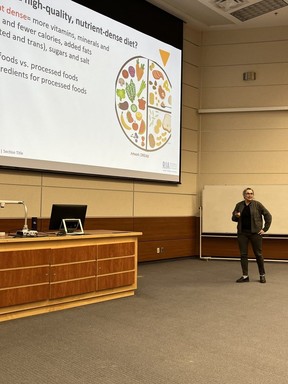How can NL improve nutrition in long-term care facilities?
Heather Keller, a registered dietitian, has created a program aimed at combating nutrition challenges among residents with dementia

Article content
Registered dietitian Heather Keller said the dining experience in long-term care facilities can be chaotic, noisy, and sometimes a place residents don’t want to be.
For seniors, eating in these facilities is not like they’re used to dining at the kitchen table. And because it’s not always as welcoming as it should be, she explained, it’s leading to nutrition challenges among residents, especially those with dementia.
Recommended Videos
Keller believes some things can be done to improve the experience and has created a program aimed at doing just that. CHOICE+, Keller explains, promotes “relationship-centred dining.”
What is relationship-centred dining?
Relationship-centred dining, or care, recognizes that the nature and quality of relationships between patients, caregivers, families, and staff significantly influence the overall health-care experience and outcomes.
Though the program is not available in NL facilities yet, Keller was invited to Memorial last week to discuss her research and share more about the benefits of her program.

The goal of CHOICE+, she explained, is to make meal times in long-term care homes more enjoyable. When meals are rushed or noisy, she said, some residents might not eat enough or at all.
Her research shows that small changes can make a big difference. That includes training staff to sit and eat with residents, and giving people time to finish their meals.
For example, she said, instead of putting a tray in front of someone, staff can ask, “Would you like the chicken or the fish today?”
“Staff are often very what I call task-focused, trying to get the job done, but not necessarily attending to some of those things that might improve the experience,” said Keller.
How can families help their loved ones?
Although staff can improve the experience, she said research shows that food intake is lower when staff assist versus when a patient’s family does.
“So, is it because they’re rushed, or is it, quite frankly, some of that social interaction — that socializing that a family member would do with a loved one helps stimulate them to eat,” said Keller.
When those with dementia are eating with a loved one, Keller said, mimicry happens. It reminds them to pick up the spoon to eat or take a sip of water.
“That happens when a family member is doing it versus a staff member, who might be rushed, assisting many people and can’t slow down, sit with them, chat with them, or eat with them. That might support the facilitation of eating,” said Keller.
How can NL improve?
In terms of food intake, Keller said preferences should be provided as well, especially cultural ones. Food is a part of a person’s identity, and not giving them options makes things challenging for them, she added.
Keller said in other provinces, such as Alberta, Nova Scotia and Manitoba, facilities have dedicated funding for meals and their menus are better in terms of nutrition density.
NL, however, doesn’t have dedicated dollars going into meals for these facilities. That’s something she believes needs to change at a policy level.
The second issue is that there aren’t enough staff hired in the kitchens. Keller said that often, there are only three people cooking for 150 residents, and when that happens, you will get prepared meals because the cooks simply can’t do it.
“It’s not feasible. So we need to invest in enough staff to make quality food, and then enough dollars to go towards the actual food itself,” said Keller.
Is NL willing to make changes?
Improving the quality of meals is one of the many recommendations in the long-term care and personal care home report released earlier this year.
Premier-designate John Hogan, who was the health minister at the time, said that improving meals is something that, in comparison to other recommendations, could be dealt with rather quickly.
The Department of Health and Community Services told The Telegram in a statement that meals provided in long-term care and personal care homes adhere to Canada’s Food Guide.
Findings from the report revealed the issues to be with limited availability of traditional foods and meal choices, as well as a lack of flexibility in meal schedules.
The department, alongside the provincial government, is now working to create legislation to improve monitoring and accountability in long-term care and personal care homes.
The scope of that legislation has not been determined, according to their statement.
This article was originally published in the St. John’s Telegram on May 7, 2025.












